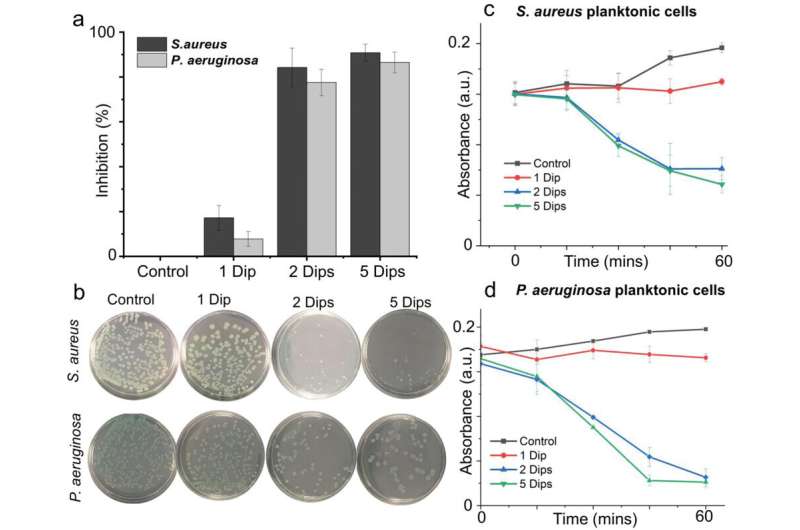April 24, 2023 report
This article has been reviewed according to Science X's editorial process and policies. Editors have highlighted the following attributes while ensuring the content's credibility:
fact-checked
peer-reviewed publication
trusted source
proofread
Smart fabric measures heart rate, heals itself

Our days of patching up or discarding torn clothing may soon be over.
An international team of researchers recently announced the development of self-healing fabric treated with liquid metal particles that can be applied to clothing, wearable electronics and health monitoring systems.
Vi Khanh Truong, co-senior author of a report published in Advanced Materials Technologies this month, said his team developed a simple process in which fabric is dipped into liquid at room temperature and then shaken in a solution for 45 minutes. The resulting microscopic particles, which Truing said look "sort of like blueberries," can be pressed onto clothing to form conductive pathways.
The liquid metal particles—composed of gallium and indium—are breathable, have low toxicity and are antimicrobial. Not only can they be used in clothing that repairs itself, but they provide a network setting for the development of sophisticated wearable electronics.
"Selectively applying stress to localized regions of the liquid metal coated textiles causes the particles to 'rupture' and merge to form percolated conductive paths," Truing explained. "Meanwhile, the rest of the LMT remains nonconductive."
The conductive particles heal on their own when cut. This characteristic "makes these textiles useful as circuit interconnects, Joule heaters and flexible electrodes to measure ECG signals," he said. They can be used to continuously monitor heart rate, for instance.
"We can customize conductive pathways as we want it," Truong said.
They also offer protection against potentially deadly bacterial infections from Pseudomonas aeruginosa and Staphylococcus aureus.
"Antibacterial properties of the LMT are identified that can prevent bacterial contamination, which can degrade textiles and infect the body," Truong, deputy director of the Biomedical Nanoengineering Laboratory at Australia's Flinders University, said. He noted the liquid metals can also combat body odor.
Truong envisioned using these materials in hospital bedding and patient clothing.
The development of this material is another step in the direction of smarter clothing for specialized and general consumer use.
Smart clothing is not new. Some of the more interesting developments in recent times include:
- Sensoria smart sox measure how far and how fast users run.
- Samsung has been working on a smart business suit that automatically swaps digital business cards and interacts with other devices.
- The Pivot Yoga Pant and Shirt combo employs 16 hidden motion sensors providing real-time body alignment feedback.
- Ralph Lauren has a line of Polo t-shirts that record fitness activities and recommend new workout routines.
- Of course, what we really needed was a pair of sneakers that can order pizza. It may sound like pie in the sky, but Pizza Hut is actually working on that one.
And who knows, with the rapid adoption of ChatGPT, we may soon be buying clothing that surveys and analyzes people and places as we cruise down the street and advises us on nearby sales, a hot rental opportunity, or maybe even a potential date—including the best spot for a great meal with fine wine, and maybe even a few good pickup lines.
More information: Jiayi Yang et al, Liquid Metal Coated Textiles with Autonomous Electrical Healing and Antibacterial Properties, Advanced Materials Technologies (2023). DOI: 10.1002/admt.202202183
© 2023 Science X Network





















